[English] 日本語
 Yorodumi
Yorodumi- PDB-8j5k: Structural insights into photosystem II supercomplex and trimeric... -
+ Open data
Open data
- Basic information
Basic information
| Entry | Database: PDB / ID: 8j5k | ||||||
|---|---|---|---|---|---|---|---|
| Title | Structural insights into photosystem II supercomplex and trimeric FCP antennae of a centric diatom Cyclotella meneghiniana | ||||||
 Components Components |
| ||||||
 Keywords Keywords |  PHOTOSYNTHESIS / PSII-FCPII supercomplex PHOTOSYNTHESIS / PSII-FCPII supercomplex | ||||||
| Function / homology |  Function and homology information Function and homology informationChem-A86 /  BETA-CAROTENE / BETA-CAROTENE /  BICARBONATE ION / BICARBONATE ION /  CHLOROPHYLL A / Chem-DD6 / DIGALACTOSYL DIACYL GLYCEROL (DGDG) / Chem-ET4 / : / PROTOPORPHYRIN IX CONTAINING FE / 1,2-DIPALMITOYL-PHOSPHATIDYL-GLYCEROLE ...Chem-A86 / CHLOROPHYLL A / Chem-DD6 / DIGALACTOSYL DIACYL GLYCEROL (DGDG) / Chem-ET4 / : / PROTOPORPHYRIN IX CONTAINING FE / 1,2-DIPALMITOYL-PHOSPHATIDYL-GLYCEROLE ...Chem-A86 /  BETA-CAROTENE / BETA-CAROTENE /  BICARBONATE ION / BICARBONATE ION /  CHLOROPHYLL A / Chem-DD6 / DIGALACTOSYL DIACYL GLYCEROL (DGDG) / Chem-ET4 / : / PROTOPORPHYRIN IX CONTAINING FE / 1,2-DIPALMITOYL-PHOSPHATIDYL-GLYCEROLE / 1,2-DISTEAROYL-MONOGALACTOSYL-DIGLYCERIDE / CA-MN4-O5 CLUSTER / CHLOROPHYLL A / Chem-DD6 / DIGALACTOSYL DIACYL GLYCEROL (DGDG) / Chem-ET4 / : / PROTOPORPHYRIN IX CONTAINING FE / 1,2-DIPALMITOYL-PHOSPHATIDYL-GLYCEROLE / 1,2-DISTEAROYL-MONOGALACTOSYL-DIGLYCERIDE / CA-MN4-O5 CLUSTER /  PHEOPHYTIN A / Chem-PL9 / Chem-SQD PHEOPHYTIN A / Chem-PL9 / Chem-SQDSimilarity search - Component | ||||||
| Biological species |  Stephanocyclus meneghinianus (Diatom) Stephanocyclus meneghinianus (Diatom) | ||||||
| Method |  ELECTRON MICROSCOPY / ELECTRON MICROSCOPY /  single particle reconstruction / single particle reconstruction /  cryo EM / Resolution: 2.93 Å cryo EM / Resolution: 2.93 Å | ||||||
 Authors Authors | Shen, L.L. / Li, Z.H. / Shen, J.R. / Wang, W.D. | ||||||
| Funding support |  China, 1items China, 1items
| ||||||
 Citation Citation |  Journal: Nat Commun / Year: 2023 Journal: Nat Commun / Year: 2023Title: Structural insights into photosystem II supercomplex and trimeric FCP antennae of a centric diatom Cyclotella meneghiniana. Authors: Songhao Zhao / Lili Shen / Xiaoyi Li / Qiushuang Tao / Zhenhua Li / Caizhe Xu / Cuicui Zhou / Yanyan Yang / Min Sang / Guangye Han / Long-Jiang Yu / Tingyun Kuang / Jian-Ren Shen / Wenda Wang /   Abstract: Diatoms are dominant marine algae and contribute around a quarter of global primary productivity, the success of which is largely attributed to their photosynthetic capacity aided by specific ...Diatoms are dominant marine algae and contribute around a quarter of global primary productivity, the success of which is largely attributed to their photosynthetic capacity aided by specific fucoxanthin chlorophyll-binding proteins (FCPs) to enhance the blue-green light absorption under water. We purified a photosystem II (PSII)-FCPII supercomplex and a trimeric FCP from Cyclotella meneghiniana (Cm) and solved their structures by cryo-electron microscopy (cryo-EM). The structures reveal detailed organizations of monomeric, dimeric and trimeric FCP antennae, as well as distinct assemblies of Lhcx6_1 and dimeric FCPII-H in PSII core. Each Cm-PSII-FCPII monomer contains an Lhcx6_1, an FCP heterodimer and other three FCP monomers, which form an efficient pigment network for harvesting energy. More diadinoxanthins and diatoxanthins are found in FCPs, which may function to quench excess energy. The trimeric FCP contains more chlorophylls c and fucoxanthins. These diversified FCPs and PSII-FCPII provide a structural basis for efficient light energy harvesting, transfer, and dissipation in C. meneghiniana. | ||||||
| History |
|
- Structure visualization
Structure visualization
| Structure viewer | Molecule:  Molmil Molmil Jmol/JSmol Jmol/JSmol |
|---|
- Downloads & links
Downloads & links
- Download
Download
| PDBx/mmCIF format |  8j5k.cif.gz 8j5k.cif.gz | 1.6 MB | Display |  PDBx/mmCIF format PDBx/mmCIF format |
|---|---|---|---|---|
| PDB format |  pdb8j5k.ent.gz pdb8j5k.ent.gz | 1.3 MB | Display |  PDB format PDB format |
| PDBx/mmJSON format |  8j5k.json.gz 8j5k.json.gz | Tree view |  PDBx/mmJSON format PDBx/mmJSON format | |
| Others |  Other downloads Other downloads |
-Validation report
| Arichive directory |  https://data.pdbj.org/pub/pdb/validation_reports/j5/8j5k https://data.pdbj.org/pub/pdb/validation_reports/j5/8j5k ftp://data.pdbj.org/pub/pdb/validation_reports/j5/8j5k ftp://data.pdbj.org/pub/pdb/validation_reports/j5/8j5k | HTTPS FTP |
|---|
-Related structure data
| Related structure data |  35987MC 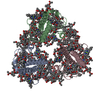 8j7zC 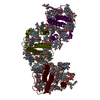 8w4oC 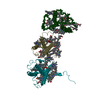 8w4pC M: map data used to model this data C: citing same article ( |
|---|---|
| Similar structure data | Similarity search - Function & homology  F&H Search F&H Search |
- Links
Links
- Assembly
Assembly
| Deposited unit | 
|
|---|---|
| 1 |
|
- Components
Components
-Protein , 17 types, 34 molecules AaBbCcDdEeHhOoQqUuVvZz507261pP...
| #1: Protein | Mass: 36951.098 Da / Num. of mol.: 2 / Source method: isolated from a natural source / Source: (natural)  Stephanocyclus meneghinianus (Diatom) Stephanocyclus meneghinianus (Diatom)#2: Protein | Mass: 53504.957 Da / Num. of mol.: 2 / Source method: isolated from a natural source / Source: (natural)  Stephanocyclus meneghinianus (Diatom) Stephanocyclus meneghinianus (Diatom)#3: Protein | Mass: 49357.348 Da / Num. of mol.: 2 / Source method: isolated from a natural source / Source: (natural)  Stephanocyclus meneghinianus (Diatom) Stephanocyclus meneghinianus (Diatom)#4: Protein | Mass: 37826.109 Da / Num. of mol.: 2 / Source method: isolated from a natural source / Source: (natural)  Stephanocyclus meneghinianus (Diatom) Stephanocyclus meneghinianus (Diatom)#5: Protein | Mass: 8687.784 Da / Num. of mol.: 2 / Source method: isolated from a natural source / Source: (natural)  Stephanocyclus meneghinianus (Diatom) Stephanocyclus meneghinianus (Diatom)#7: Protein | Mass: 7188.501 Da / Num. of mol.: 2 / Source method: isolated from a natural source / Source: (natural)  Stephanocyclus meneghinianus (Diatom) Stephanocyclus meneghinianus (Diatom)#14: Protein | Mass: 26749.297 Da / Num. of mol.: 2 / Source method: isolated from a natural source / Source: (natural)  Stephanocyclus meneghinianus (Diatom) Stephanocyclus meneghinianus (Diatom)#15: Protein | Mass: 16001.864 Da / Num. of mol.: 2 / Source method: isolated from a natural source / Source: (natural)  Stephanocyclus meneghinianus (Diatom) Stephanocyclus meneghinianus (Diatom)#17: Protein | Mass: 10010.334 Da / Num. of mol.: 2 / Source method: isolated from a natural source / Source: (natural)  Stephanocyclus meneghinianus (Diatom) Stephanocyclus meneghinianus (Diatom)#18: Protein | Mass: 14757.663 Da / Num. of mol.: 2 / Source method: isolated from a natural source / Source: (natural)  Stephanocyclus meneghinianus (Diatom) Stephanocyclus meneghinianus (Diatom)#22: Protein | Mass: 6233.312 Da / Num. of mol.: 2 / Source method: isolated from a natural source / Source: (natural)  Stephanocyclus meneghinianus (Diatom) Stephanocyclus meneghinianus (Diatom)#23: Protein | Mass: 18512.004 Da / Num. of mol.: 2 / Source method: isolated from a natural source / Source: (natural)  Stephanocyclus meneghinianus (Diatom) Stephanocyclus meneghinianus (Diatom)#24: Protein | Mass: 18251.734 Da / Num. of mol.: 2 / Source method: isolated from a natural source / Source: (natural)  Stephanocyclus meneghinianus (Diatom) Stephanocyclus meneghinianus (Diatom)#25: Protein | Mass: 18085.545 Da / Num. of mol.: 2 / Source method: isolated from a natural source / Source: (natural)  Stephanocyclus meneghinianus (Diatom) Stephanocyclus meneghinianus (Diatom)#26: Protein | Mass: 23279.170 Da / Num. of mol.: 2 / Source method: isolated from a natural source / Source: (natural)  Stephanocyclus meneghinianus (Diatom) Stephanocyclus meneghinianus (Diatom)#27: Protein | Mass: 13039.064 Da / Num. of mol.: 2 / Source method: isolated from a natural source / Source: (natural)  Stephanocyclus meneghinianus (Diatom) Stephanocyclus meneghinianus (Diatom)#28: Protein | Mass: 17850.197 Da / Num. of mol.: 2 / Source method: isolated from a natural source / Source: (natural)  Stephanocyclus meneghinianus (Diatom) Stephanocyclus meneghinianus (Diatom) |
|---|
-Protein/peptide , 11 types, 22 molecules FfIiJjKkLlMmNnTtWwXxYy
| #6: Protein/peptide | Mass: 3555.263 Da / Num. of mol.: 2 / Source method: isolated from a natural source / Source: (natural)  Stephanocyclus meneghinianus (Diatom) Stephanocyclus meneghinianus (Diatom)#8: Protein/peptide | Mass: 3940.673 Da / Num. of mol.: 2 / Source method: isolated from a natural source / Source: (natural)  Stephanocyclus meneghinianus (Diatom) Stephanocyclus meneghinianus (Diatom)#9: Protein/peptide | Mass: 3487.078 Da / Num. of mol.: 2 / Source method: isolated from a natural source / Source: (natural)  Stephanocyclus meneghinianus (Diatom) Stephanocyclus meneghinianus (Diatom)#10: Protein/peptide | Mass: 4225.085 Da / Num. of mol.: 2 / Source method: isolated from a natural source / Source: (natural)  Stephanocyclus meneghinianus (Diatom) Stephanocyclus meneghinianus (Diatom)#11: Protein/peptide | Mass: 4235.880 Da / Num. of mol.: 2 / Source method: isolated from a natural source / Source: (natural)  Stephanocyclus meneghinianus (Diatom) Stephanocyclus meneghinianus (Diatom)#12: Protein/peptide | Mass: 4358.022 Da / Num. of mol.: 2 / Source method: isolated from a natural source / Source: (natural)  Stephanocyclus meneghinianus (Diatom) Stephanocyclus meneghinianus (Diatom)#13: Protein/peptide | Mass: 2571.161 Da / Num. of mol.: 2 / Source method: isolated from a natural source / Source: (natural)  Stephanocyclus meneghinianus (Diatom) Stephanocyclus meneghinianus (Diatom)#16: Protein/peptide | Mass: 3441.195 Da / Num. of mol.: 2 / Source method: isolated from a natural source / Source: (natural)  Stephanocyclus meneghinianus (Diatom) Stephanocyclus meneghinianus (Diatom)#19: Protein/peptide | Mass: 5606.405 Da / Num. of mol.: 2 / Source method: isolated from a natural source / Source: (natural)  Stephanocyclus meneghinianus (Diatom) Stephanocyclus meneghinianus (Diatom)#20: Protein/peptide | Mass: 3389.061 Da / Num. of mol.: 2 / Source method: isolated from a natural source / Source: (natural)  Stephanocyclus meneghinianus (Diatom) Stephanocyclus meneghinianus (Diatom)#21: Protein/peptide | Mass: 3634.343 Da / Num. of mol.: 2 / Source method: isolated from a natural source / Source: (natural)  Stephanocyclus meneghinianus (Diatom) Stephanocyclus meneghinianus (Diatom) |
|---|
-Sugars , 1 types, 8 molecules 
| #39: Sugar | ChemComp-DGD / |
|---|
-Non-polymers , 15 types, 328 molecules 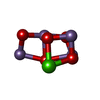





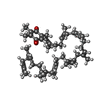



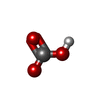

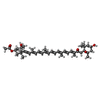
















| #29: Chemical | | #30: Chemical | #31: Chemical | ChemComp-CLA /  Chlorophyll a Chlorophyll a#32: Chemical | ChemComp-PHO /  Pheophytin Pheophytin#33: Chemical | ChemComp-BCR /  Β-Carotene Β-Carotene#34: Chemical | ChemComp-SQD / #35: Chemical | ChemComp-PL9 /  Plastoquinone Plastoquinone#36: Chemical | ChemComp-LHG /  Phosphatidylglycerol Phosphatidylglycerol#37: Chemical | ChemComp-LMG / #38: Chemical |  Chloride Chloride#40: Chemical |  Bicarbonate Bicarbonate#41: Chemical | ChemComp-HEM /  Heme B Heme B#42: Chemical | ChemComp-A86 / (  Fucoxanthin Fucoxanthin#43: Chemical | |
|---|
 Movie
Movie Controller
Controller





 PDBj
PDBj






















